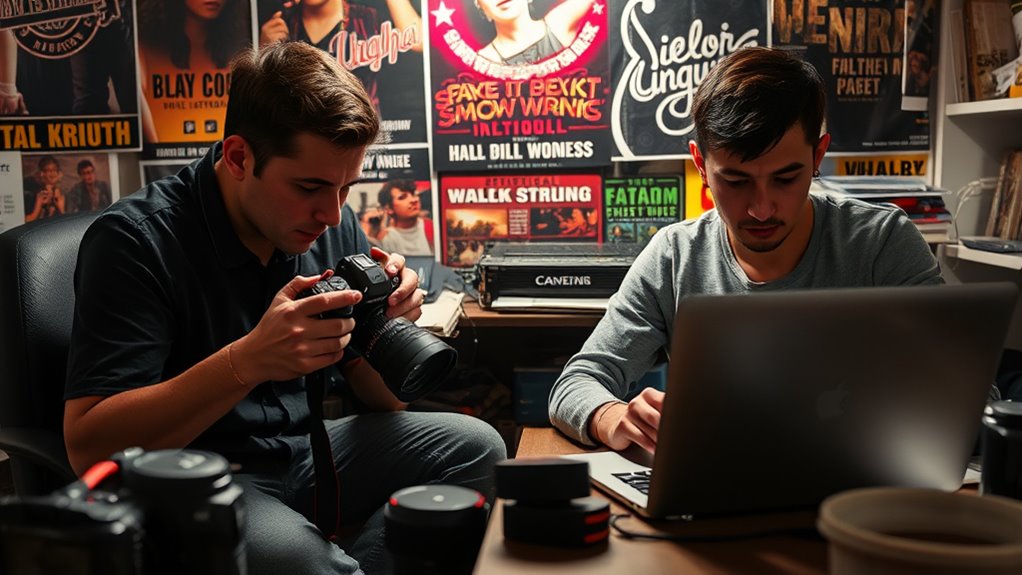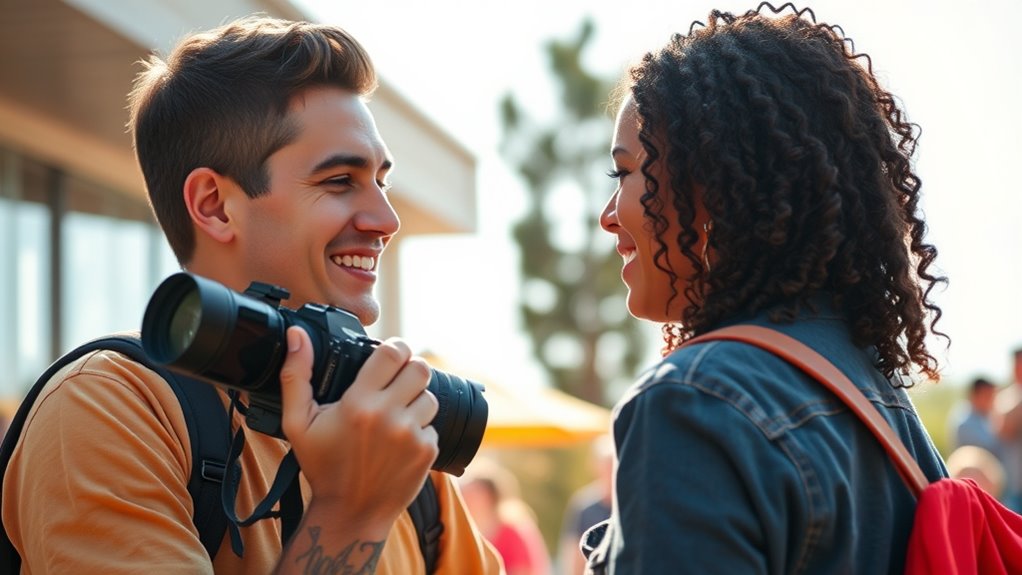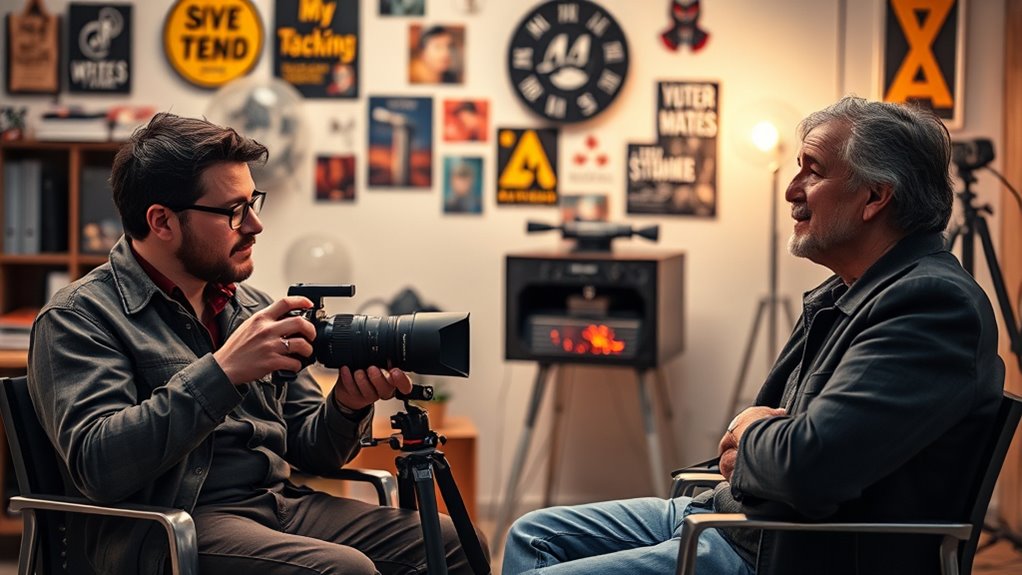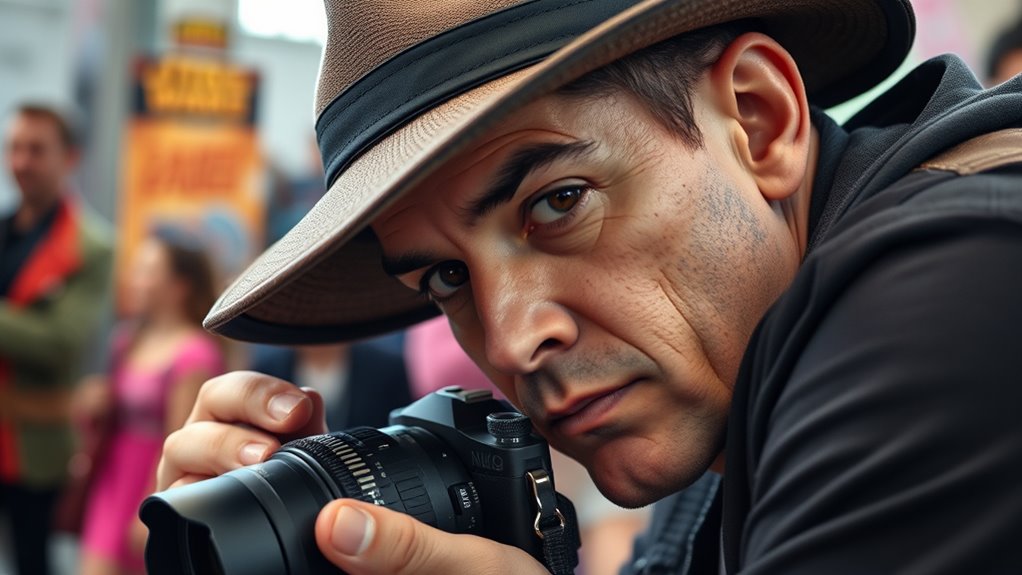When you interview fan-culture photographers about ethics, you’ll find they emphasize respecting privacy and obtaining consent before photographing individuals, especially in sensitive situations. They stress balancing artistic freedom with cultural sensitivities and avoiding intrusive shots. Building trust with fans and subjects is vital, as is being transparent about how images will be shared online. To understand how these photographers navigate complex ethical landscapes and maintain professionalism, keep exploring these insightful perspectives.
Key Takeaways
- Ethical fan-culture photographers prioritize obtaining consent and respecting privacy, especially in sensitive or private moments.
- They emphasize cultural sensitivity, ensuring accurate representation and avoiding exploitation of fan interactions.
- Maintaining professionalism involves staying calm during conflicts and clearly explaining roles and boundaries.
- Responsible sharing includes respecting subjects’ wishes online and being transparent about image use and sharing plans.
- Future norms focus on adapting practices to digital privacy standards while honoring fan boundaries and community expectations.
Navigating Consent in Fan Photography

Managing consent in fan photography can be tricky because fans often want to capture moments without fully considering the artist’s comfort. When you’re engaging in fan interactions, it’s essential to read the situation carefully. Not everyone is comfortable with being photographed, especially in certain cultural contexts where privacy or modesty is highly valued. Respect cultural sensitivities by observing how the artist or fans respond to your camera. If in doubt, ask politely before taking a photo, rather than assuming consent. Building trust through respectful behavior encourages more genuine interactions and helps avoid discomfort or misunderstandings. Remember, understanding and honoring these boundaries demonstrates professionalism and shows that you value the artist’s and fans’ well-being above all.
Respecting Privacy in Public Spaces

When photographing in public spaces, you need to consider consent and awareness—you shouldn’t assume everyone is comfortable being photographed. People expect a certain level of privacy, even in crowded areas, so respecting their boundaries is essential. By being mindful of these limits, you help protect individuals’ privacy and maintain ethical standards in fan photography. Additionally, understanding the regulations surrounding photography can help ensure you stay within legal boundaries and avoid potential issues.
Consent and Awareness
In public spaces, photographers must be mindful of individuals’ privacy and their right to consent before capturing images. Respecting fan interactions involves understanding when someone prefers not to be photographed. As a photographer, your responsibilities include gauging comfort levels and seeking permission when possible. Keep these points in mind:
- Approach fans politely before taking photos.
- Recognize signs of discomfort or reluctance.
- Clearly ask for consent, especially in close-up shots.
- Respect a fan’s decision to decline, without argument or pressure.
- Being aware of color accuracy and how it affects the overall perception of images can help you better gauge appropriate moments to photograph.
Being aware of consent fosters trust and avoids potential conflicts. By prioritizing awareness and respecting privacy, you uphold ethical standards and contribute to a positive fan culture. Your role isn’t just about capturing moments; it’s about respecting the people behind them.
Public Space Expectations
While public spaces are open to everyone, as a photographer, you must still respect individuals’ privacy and personal boundaries. During fan interaction and event coverage, be mindful of how close you get and what you capture. Not everyone wants to be part of the photos, even if they’re in a public area. Avoid intrusive shots that could make people uncomfortable or feel exposed. Focus on capturing the energy of the event without overstepping personal space. Remember, just because a fan is in a public setting doesn’t mean they consent to being photographed or identified. Respect their right to enjoy the event without feeling surveilled. Being aware of the cost of security systems in your environment can also help you gauge how much privacy might be expected in certain areas. Maintaining this awareness helps you build trust and keeps your photography ethical and respectful.
Privacy Boundaries Respect
Respecting privacy boundaries in public spaces requires you to recognize that not everyone wants to be photographed or identified, even if they’re visible in a public setting. Respecting celebrity boundaries means understanding their right to privacy outside of official events. Be mindful of digital footprints, as photos can easily be shared online and impact someone’s reputation. To ensure ethical behavior:
- Always ask for permission before photographing someone, especially if they’re clearly uncomfortable.
- Avoid capturing images of children or vulnerable individuals without consent.
- Recognize that public visibility doesn’t equate to consent for all types of photos.
- Consider how your images might affect the subject’s reputation or digital footprint, and act accordingly.
Balancing Artistic Expression and Ethical Responsibility

As a fan-culture photographer, you need to find the right balance between creative freedom and respecting others’ boundaries. Managing consent challenges can be tricky, especially in crowded spaces where privacy isn’t always clear. Staying true to your artistic vision while acting ethically ensures your work respects both your subjects and your integrity. Being aware of essential oils for ethical use can also remind you to consider the ethical implications of your actions and maintain professionalism.
Respecting Privacy Boundaries
Balancing artistic expression with ethical responsibility requires photographers to be mindful of privacy boundaries, especially when capturing candid moments at events or in public spaces. Respecting fan interactions means recognizing that not every moment is for public consumption. To maintain ethical standards, consider these points:
- Avoid intrusive shots during private fan interactions.
- Respect signs or signals indicating a fan’s discomfort.
- Maintain clear photographer boundaries, especially around vulnerable moments.
- Prioritize consent when possible, even in public settings.
- Recognize that emotional distance can develop if boundaries are not respected, which may impact future collaborations.
Focusing on these aspects helps you honor fans’ privacy while still capturing authentic images. Remember, pushing boundaries can damage your reputation and harm those you’re photographing. Responsible photography balances artistic intent with respect for individual privacy.
Navigating Consent Challenges
Managing consent challenges can be complex, especially when aiming to capture genuine moments without crossing ethical lines. You must be culturally sensitive, recognizing different comfort levels and social norms within fan communities. Respect for individuals’ boundaries is key, but legal implications also come into play; capturing images without permission can lead to legal trouble. To navigate this, seek explicit consent when possible, especially in private or sensitive settings. Be aware of cultural differences that influence how people want to be portrayed, and adjust your approach accordingly. Remember, balancing artistic expression with ethical responsibility isn’t just about avoiding legal issues—it’s about respecting the people you photograph. Prioritizing consent helps you build trust and ensures your work remains respectful and sustainable. Understanding electric power generation with bike generators is also important for creating ethically responsible content in certain contexts.
Maintaining Artistic Integrity
Maintaining artistic integrity means staying true to your creative vision while respecting the boundaries set by your subjects and the community. In fan culture photography, your goal is to craft powerful visual storytelling that captures authentic moments without exploiting or misrepresenting others. To do this effectively, keep these principles in mind:
- Prioritize respectful portrayal over sensationalism
- Ensure your work accurately reflects cultural representation
- Seek consent when possible, especially for sensitive images
- Balance artistic expression with ethical responsibility
- Incorporate authentic decor elements to enhance the genuine atmosphere of your photographs.
Handling Sensitive Situations and Potential Conflicts

When photographers encounter sensitive situations or potential conflicts, quick judgment and respectful behavior are essential. You need to stay calm and prioritize respect for fans and performers. If a fan becomes upset or confronts you, calmly explain your role and the importance of event permissions. Sometimes, fan interactions can become tense, so it’s *vital* to set boundaries without escalating the situation. Being aware of celebrity privacy concerns can help guide your reactions and ensure you handle situations ethically. Handling conflicts tactfully upholds your integrity and preserves the experience for everyone involved.
The Impact of Online Sharing and Image Circulation

Online sharing has dramatically amplified the reach of fan-culture photographs, making images accessible to a global audience within moments. This rapid digital dissemination boosts fan engagement but also raises ethical concerns. You need to contemplate how your images are used and shared, as once online, they can spread uncontrollably. To navigate this, keep these points in mind:
- Respect subjects’ privacy when sharing images.
- Avoid posting photos that could be misused or misinterpreted.
- Understand that your images contribute to the broader fan community.
- Recognize your responsibility in maintaining ethical standards amid widespread circulation.
The ease of digital dissemination means your photos can influence perceptions, so it’s crucial to share thoughtfully and ethically, balancing fan engagement with respect for subjects’ rights.
Building Trust With Fans and Subjects

Building trust with fans and subjects is fundamental to ethical fan-culture photography, especially as digital sharing can quickly erode personal boundaries. You should prioritize genuine fan interaction, listening carefully to their comfort levels and respecting their wishes. Being transparent about your intentions and how you plan to use the images fosters trust and shows you value their privacy. When you openly communicate, fans feel more comfortable engaging with you, knowing you’re honest about your work. Avoid surprises or manipulative tactics that could damage relationships. Consistently demonstrating photographer transparency helps build credibility and long-term trust. Remember, earning trust isn’t just about capturing great images — it’s about creating respectful, authentic connections with those you photograph. Incorporating clear privacy policies and respecting cookie preferences further demonstrates your commitment to ethical practices and builds trust with your audience.
Evolving Norms and Future Considerations in Fan-Culture Photography

As fan culture continues to evolve, so do the norms and expectations surrounding photography within these communities. You’ll notice that fan interactions are becoming more respectful, with communities emphasizing consent and privacy. The influence of photographers grows as they shape perceptions and set standards for ethical behavior. To navigate future challenges, consider these key points:
- Respect fan boundaries and seek consent before photographing.
- Recognize your influence and avoid exploiting fan interactions for personal gain.
- Promote transparency about how images will be used or shared.
- Adapt to digital advancements, ensuring privacy and ethical standards keep pace.
- Understanding fan-culture norms helps photographers align their practices with community expectations and foster respectful environments.
Frequently Asked Questions
How Do Photographers Handle Cultural Differences in Fan Interactions?
When you handle cultural differences in fan interactions, you prioritize cultural sensitivity and respectful engagement. You research and understand diverse customs, avoiding assumptions. By listening actively and respecting personal boundaries, you build trust and rapport. You remain aware of your own biases, adapting your approach accordingly. This mindful attitude fosters positive connections, ensuring your photography respects and celebrates the cultural richness of the fans you interact with.
What Legal Repercussions Can Photographers Face for Unauthorized Images?
You could face legal repercussions like copyright issues and privacy concerns if you take unauthorized images. Using someone’s likeness without permission may lead to lawsuits, and sharing private moments can violate privacy laws. Always make certain you have permission before capturing or sharing photos, especially in sensitive settings. Ignoring these rules risks financial penalties, reputational damage, and legal action, so it’s vital to respect rights and obtain consent whenever possible.
How Do Photographers Manage Their Mental Health Amid Fan Interactions?
You should prioritize mental health awareness by recognizing when fan interactions become overwhelming. Setting boundaries is essential; let fans know what’s comfortable and what isn’t. Take breaks if needed and seek support from friends, colleagues, or mental health professionals. Managing your mental health helps you stay grounded, maintain your passion, and enjoy your work without burnout. Remember, protecting your well-being is just as important as capturing great photos.
What Are Best Practices for Photographing Minors in Fan Settings?
When photographing minors in fan settings, you should prioritize consent protocols and privacy considerations. Always seek permission from a guardian before capturing images of minors, and respect their comfort levels. Keep sensitive images private, avoid sharing identifiable photos without explicit approval, and be mindful of how your photos might impact their privacy. By following these best practices, you help protect minors’ rights and foster a respectful, ethical environment.
How Can Photographers Ethically Monetize Fan-Culture Images?
Think of monetizing fan-culture images like trading treasures. You must respect fan consent, ensuring they’re aware and okay with your use. Use clear image licensing agreements to protect both sides. By doing so, you honor trust and transparency, turning your work into a fair exchange rather than exploitation. When you prioritize consent and proper licensing, you create a sustainable way to ethically profit from your photography, much like a responsible steward of the fandom’s treasures.
Conclusion
As you continue to capture fan moments, remember that ethics aren’t static—they evolve with each photo you take. Will you prioritize consent or risk crossing boundaries? How will online sharing shape perceptions and trust? The future of fan-culture photography hinges on your choices today. Stay mindful, stay respectful, and be prepared for surprises you never saw coming. Because in this world of images and influence, the next chapter is yours to write—what will it hold?









